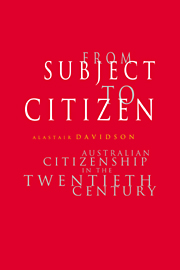Book contents
- Frontmatter
- Contents
- List of Figures
- List of Tables
- Acknowledgments
- Abbreviations
- Introduction
- PART I From Subject to Citizen 1901–1996
- 1 Civis Romanus Sum
- 2 From Subject to Citizen I: to 1948
- 3 Nationality and the Citizen II: 1948–1986
- 4 From Subject to Citizen III: 1983–1996
- Part II Discourses of Exclusion
- Part III The Active Citizen and Beyond
- Conclusion
- Notes
- Select Bibliography
- Index
2 - From Subject to Citizen I: to 1948
Published online by Cambridge University Press: 06 January 2010
- Frontmatter
- Contents
- List of Figures
- List of Tables
- Acknowledgments
- Abbreviations
- Introduction
- PART I From Subject to Citizen 1901–1996
- 1 Civis Romanus Sum
- 2 From Subject to Citizen I: to 1948
- 3 Nationality and the Citizen II: 1948–1986
- 4 From Subject to Citizen III: 1983–1996
- Part II Discourses of Exclusion
- Part III The Active Citizen and Beyond
- Conclusion
- Notes
- Select Bibliography
- Index
Summary
The man can naturalise the woman but the woman cannot naturalise the man.
Senator J. G. Drake, Parliament House, Canberra 1903‘Alien’ means a person who is not a British subject, an Irish citizen, or a protected person.
Australian Nationality and Citizenship Act, 1948Once viewed in the context of the developments in the understanding of citizenship traced in the first chapter, we can see that any history of Australian citizenship can have very little to do with the Greek model. The emphasis of present government policy on the notion of civic virtue in that model as a guide to reactivating citizenship in Australia is thus misplaced. What is clearly of great significance for understanding Australian citizenship has been the development of a citizenship, appropriate to the context of a nation-state, since for a hundred years Australian policy-makers have sought to build a nation-state here. The new challenge for 2001 is to square what has been created here with the requirements for a citizen appropriate to future regional economies in a global world.
That will be a considerable task as Australian history was bizarrely like those of the late-comers in nation-state Europe. Here, until 1982 the state attempted to impose on a widely diverse set of ethnic groups a single identity based on a partial collective memory. Increasingly, this has meant less and less to large sections of the population.
- Type
- Chapter
- Information
- From Subject to CitizenAustralian Citizenship in the Twentieth Century, pp. 45 - 83Publisher: Cambridge University PressPrint publication year: 1997



